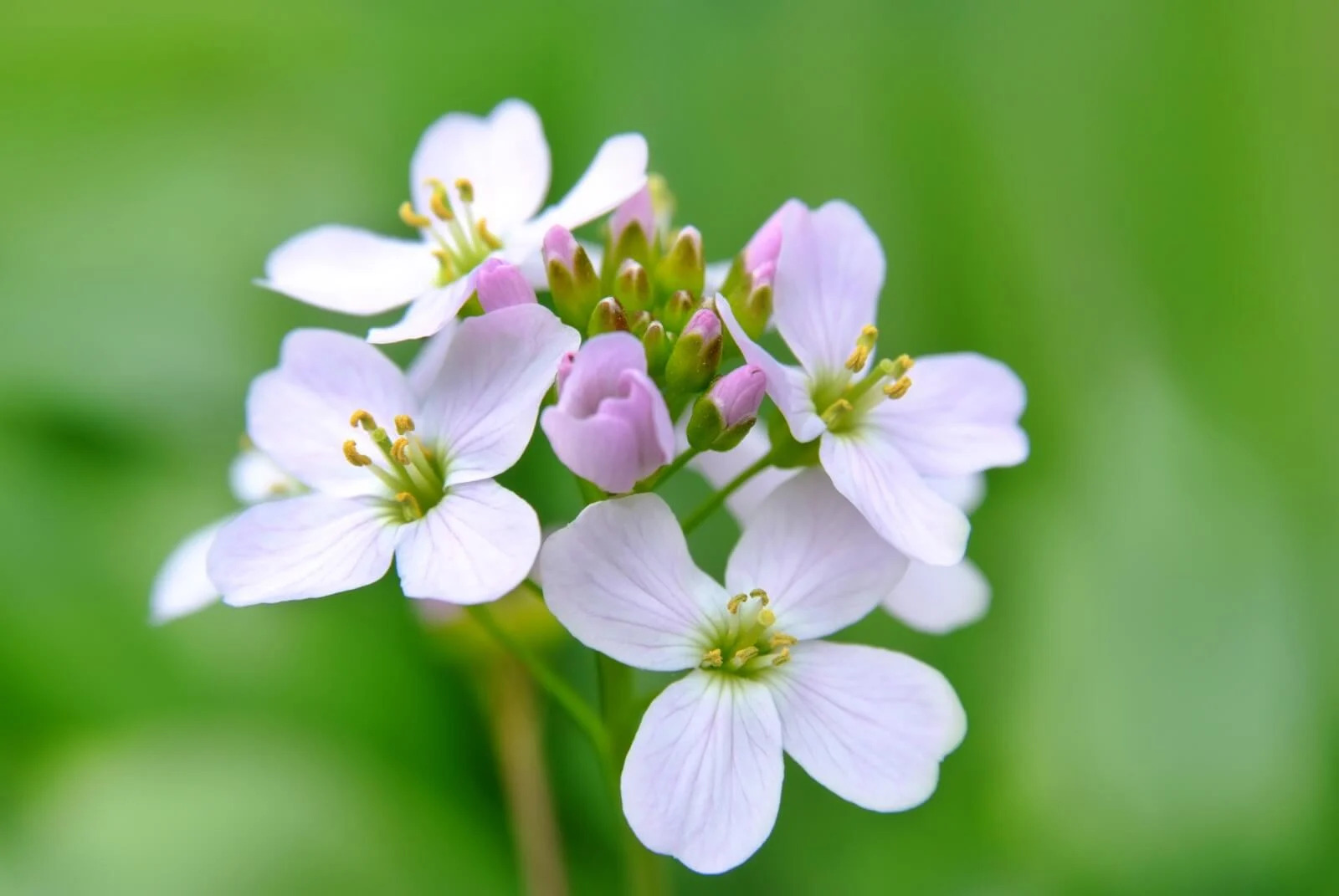
The Cuckoo Flower, scientifically known as Cardamine pratensis, is a fascinating plant that is often overlooked despite its unique characteristics. This perennial herbaceous plant belongs to the mustard family and is native to Europe and Asia. It is often found in damp meadows, woodlands, and along riverbanks, and its delicate pink or lilac flowers are a beautiful sight to behold.
In this article, we will dive into 16 fascinating facts about the Cuckoo Flower. From its historical uses to its ecological significance, these facts will shed light on the incredible world of this understated plant. So, let’s discover the intriguing details about the Cuckoo Flower and get ready to be amazed by its impressive qualities!
Key Takeaways:
- Cuckoo Flower, also known as Lady’s Smock, is a vibrant and adaptable wildflower that attracts pollinators and has been used for various purposes throughout history.
- This delicate plant, with its explosive seed dispersal and folklore associations, symbolizes renewal and is a favorite among gardeners for its elegant appearance.
The Cuckoo Flower, also known as Lady’s Smock, is a delicate and beautiful perennial plant that belongs to the Brassicaceae family.
Native to Europe and Asia, this wildflower is commonly found in meadows, damp grasslands, and along riverbanks.
The scientific name of the Cuckoo Flower is Cardamine pratensis.
This name is derived from the Greek word “cardamine,” which means “to purge,” due to the plant’s historical use as a medicinal herb.
The Cuckoo Flower gets its name from the belief that it blooms in sync with the arrival of the cuckoo bird.
According to folklore, the cuckoo bird’s call coincides with the appearance of this beautiful flower, heralding the arrival of spring.
This flower is known for its vibrant hues and delicate petals, which range from pale pink to lilac and sometimes even white.
Its bloom time typically lasts from April to June, making it a popular sight during the spring season.
The Cuckoo Flower is not just visually appealing; it also plays a vital role in supporting biodiversity.
Its nectar-rich flowers attract a variety of pollinators, including bees, butterflies, and hoverflies, helping to sustain local ecosystems.
In addition to its ornamental value, the Cuckoo Flower has been used for various purposes throughout history.
Its leaves have been consumed as a spring green vegetable and used in traditional herbal remedies to treat ailments.
Cuckoo Flower is incredibly adaptable and can thrive in a wide range of soil types and moisture levels.
Its ability to grow in wet environments makes it an excellent addition to rain gardens and natural wetland restorations.
This flower’s seeds are dispersed through explosive mechanisms.
When the seed pods mature, they abruptly burst open, flinging the seeds several feet away from the plant.
The Cuckoo Flower is a favorite among gardeners and can be cultivated in home gardens with ease.
Its graceful and dainty appearance adds an elegant touch to any flower bed or border.
In folklore, it is believed that the Cuckoo Flower possesses mystical powers and can bring good luck and love to those who carry it.
It has been used in love spells and as a talisman of protection and fertility.
Despite being a delicate plant, the Cuckoo Flower is surprisingly hardy.
It can withstand cool temperatures and even thrive in regions with harsh climates.
The Cuckoo Flower is also an indicator of waterlogged or poorly drained soil.
If you come across this flower in the wild, it’s a sign that the area is prone to dampness.
This plant is an important food source for several species of caterpillars.
Butterflies such as the Orange-tip and Green-veined White rely on the Cuckoo Flower as a host plant for their larvae.
The Cuckoo Flower has been associated with various symbolic meanings throughout history.
It is often seen as a representation of gentleness, purity, and renewal.
This flower is known by different names in various parts of the world.
In North America, it is sometimes referred to as “Meadow Cress,” while in some regions of the United Kingdom, it is called “Milkmaids.
The Cuckoo Flower has been the subject of several poems and literary works.
Its ethereal beauty and connection to nature have inspired many writers and artists throughout the centuries.
These 16 fascinating facts about Cuckoo Flower showcase the diverse and intriguing characteristics of this captivating plant.
Conclusion
In conclusion, the cuckoo flower is a fascinating plant with a rich history and an array of interesting attributes. Its unique name originates from the belief that the blooming of this flower coincided with the arrival of the cuckoo bird in Europe. Cuckoo flowers are not only visually stunning with their delicate pink and lilac petals, but they also serve as an important source of nectar for pollinators.The cuckoo flower’s ability to thrive in wetland areas and its adaptability to various climates make it a resilient plant. Its medicinal properties have been recognized for centuries, with traditional uses ranging from treating heart ailments to relieving respiratory symptoms.With its enchanting appearance, cultural significance, and ecological importance, the cuckoo flower truly deserves appreciation. Whether you encounter it in the wild or choose to cultivate it in your own garden, this wonderful plant is sure to bring beauty and wonder to any space.
FAQs
1. What is the scientific name of the cuckoo flower?
The scientific name of the cuckoo flower is Cardamine pratensis.
2. Where can cuckoo flowers be found?
Cuckoo flowers can be found in various parts of Europe, Asia, and North America, particularly in damp meadows, marshes, and riverbanks.
3. Are cuckoo flowers poisonous?
No, cuckoo flowers are not poisonous. In fact, they have been consumed in some cultures as a salad green or cooked vegetable.
4. Do cuckoo flowers have any cultural significance?
Yes, cuckoo flowers have cultural significance in many European countries. They are often associated with the arrival of spring and the mating season of the cuckoo bird.
5. Can cuckoo flowers attract pollinators?
Absolutely! The vibrant colors and sweet fragrance of cuckoo flowers attract a variety of pollinators, including bees, butterflies, and hoverflies.
Remember, the cuckoo flower is a wonderful plant that not only adds beauty to our surroundings but also plays a crucial role in supporting the ecosystem. So, the next time you spot this enchanting flower, take a moment to appreciate its fascinating existence.
Enchanted by Cuckoo Flower's allure? Dive deeper into nature's marvels! Uncover 19 astonishing facts about Hepatica, another captivating perennial plant. Expand your knowledge with 11 enigmatic facts about botany, the fascinating science behind flora. Immerse yourself in awe-inspiring nature facts that'll leave you breathless. Embark on a journey of discovery, where every petal tells a story and every leaf holds a secret waiting to be unveiled.
Was this page helpful?
Our commitment to delivering trustworthy and engaging content is at the heart of what we do. Each fact on our site is contributed by real users like you, bringing a wealth of diverse insights and information. To ensure the highest standards of accuracy and reliability, our dedicated editors meticulously review each submission. This process guarantees that the facts we share are not only fascinating but also credible. Trust in our commitment to quality and authenticity as you explore and learn with us.


